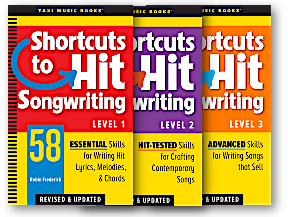Today’s melodies and many of the great melodies of past rely on a handful of tricks to create that special something that makes them insanely catchy and memorable.
Here are three tips that will help you make sure your melody has everything it needs before you launch it into the world.
1.Use your melody to create unforgettable song structure.
If your song has a VERSE / CHORUS structure, make sure listeners know where they are by creating plenty of contrast in the melody between these two sections. Melodic contrast grabs attention and keeps your melody from sounding like it’s wandering aimlessly. Listeners like to have a sense of “place” in a song. They want to know where they are.
- Try a big leap up (or down) in the melody to launch your chorus. Then stay up there for a couple of lines before gradually dropping down to the verse note range. You can hear this is big hit songs like Adele’s “Set Fire to the Rain” and “Roar” by Katy Perry.
- Use a choppy melody in your verse with plenty of fast-paced notes. Then change to a smoother melody style in the chorus. Check out “I’m Yours” by Jason Mraz or “Vertigo” by U2 to hear this type of melody structure.
2. Make sure your melody has a good mix of repetition and variation
Repetition helps listeners remember a melody. But too much repetition can become boring. Varying your melody can keep it interesting. But too much variety can make your melody lose focus and memorability. What you need to find is the “Goldilocks” spot – the mix of repetition and variation that keeps a melody both memorable and interesting.
- The Goldilocks spot will be different for every song but there are a few general ideas that work. For example, it’s okay to repeat a melody line, but if you repeat it a third time listeners might start to tune out Try varying your third line, then you can come back to your original line again.
- Watch out for the “see-saw” effect—a pair of similar melody lines that are repeated over and over. If there’s enough variation between the two lines, you could repeat them a couple times, but after that try going someplace different, maybe a series of short repeated phrases with a lot of rhythmic interest, or a line moves in a different up or down direction.

3. Vary the length of your lines
We often focus on the note pitches of a melody—the rising and falling motion. But the length of your lines is just as important as changes in pitch. A melody that consists of lines that are all the same length runs the risk of becoming predictable. Try varying the the length of your phrases.
- Use two short, repeated phrases instead of one long line.
- Run two lines together to make a phrase that’s longer than expected.
- Add a few notes and words to the end of a line to create extra length.
Any of these ideas will help you create a melody that sustains interest while remaining memorable.
Study hit songs to hear more tips for writing memorable melodies
All of these melody writing tips are used in hit songs. They’re what give these songs their catchy, interesting, and compelling quality. I have 50+ Hit Song Guides that will walk you through today’s biggest hits. In each one I’ll show you how the songwriters used techniques like these to give their songs the kind of melody listeners love. Then try some of those ideas in a melody of your own.
by Robin Frederick
